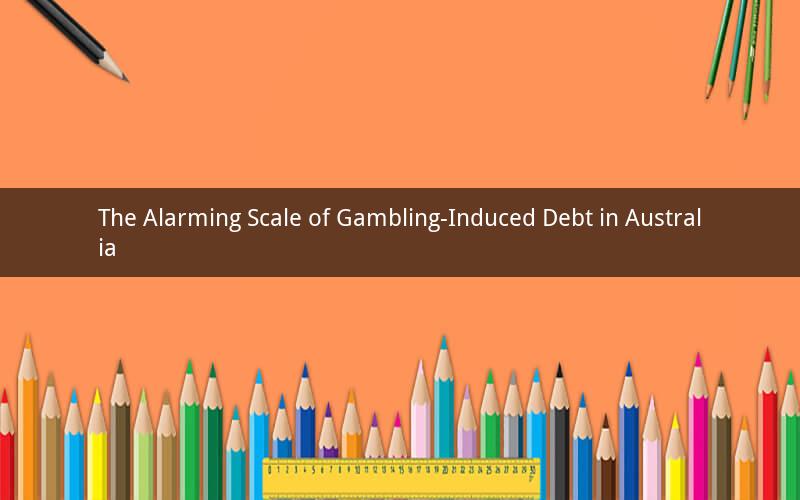
Introduction:
Gambling has been a prevalent activity in Australia for many years, captivating both locals and tourists. However, the rise in gambling addiction has led to a significant increase in gambling-induced debt. This article delves into the alarming scale of debt caused by gambling in Australia, exploring the factors contributing to this issue and the repercussions it has on individuals and society.
1. The Scope of Gambling-Induced Debt in Australia
The scale of gambling-induced debt in Australia is substantial, affecting a considerable number of individuals. According to a report by the Australian Institute of Health and Welfare, around 1.9% of the Australian population, which equates to approximately 430,000 people, are considered problem gamblers. These individuals are more likely to accumulate substantial debt as a result of their gambling habits.
1.1 The Cost to Individuals
The financial burden of gambling-induced debt is immense. Problem gamblers often find themselves struggling to meet their basic needs, such as rent, utilities, and groceries. This financial strain can lead to increased stress, anxiety, and even depression. In some cases, individuals resort to borrowing money from friends, family, or even engaging in illegal activities to repay their debts.
1.2 The Impact on Families
Gambling-induced debt extends beyond the individual and affects families as a whole. Spouses, children, and other dependents bear the brunt of the financial strain caused by a loved one's gambling addiction. Relationships can suffer, and the overall well-being of the family is compromised. The emotional toll on loved ones is often overlooked, but it is equally significant.
2. Factors Contributing to Gambling-Induced Debt
Several factors contribute to the alarming scale of gambling-induced debt in Australia. Understanding these factors is crucial in developing effective strategies to mitigate the issue.
2.1 Accessibility to Gambling Facilities
Australia boasts a vast array of gambling venues, including casinos, racetracks, poker machines, and online gambling platforms. The easy accessibility of these facilities makes it more likely for individuals to engage in gambling activities and accumulate debt.
2.2 Marketing and Advertising
The gambling industry invests heavily in marketing and advertising campaigns, often targeting vulnerable individuals. The allure of big wins and the glamorous lifestyle associated with gambling can entice individuals to take on excessive debt.
2.3 The Psychological Aspect of Gambling
Gambling is often seen as a form of entertainment, but it can be addictive. The psychological aspect of gambling, including the thrill of risk and the potential for instant gratification, can lead individuals to take on excessive debt in pursuit of these feelings.
3. The Economic Impact of Gambling-Induced Debt
The economic impact of gambling-induced debt is far-reaching, affecting both individuals and the broader economy.
3.1 Loss of Productivity
Individuals struggling with gambling-induced debt may find it difficult to maintain employment or fulfill their responsibilities. This loss of productivity can have a ripple effect on the economy, leading to decreased tax revenues and increased welfare costs.
3.2 Burden on the Healthcare System
The mental and physical health consequences of gambling-induced debt can put a strain on the healthcare system. Problem gamblers are more likely to experience stress-related disorders, anxiety, depression, and even suicide attempts.
4. Addressing the Issue
Efforts to address the issue of gambling-induced debt in Australia have been ongoing. Here are some potential solutions:
4.1 Strengthening Regulations
Implementing stricter regulations on gambling can help mitigate the risk of excessive debt. This includes limiting the number of gambling venues, imposing stricter advertising restrictions, and imposing mandatory pre-commitment schemes for poker machines.
4.2 Providing Support and Treatment
Increasing access to support and treatment services for problem gamblers is crucial. This includes counseling, therapy, and support groups. Education and awareness campaigns can also help individuals recognize the signs of gambling addiction and seek help.
4.3 Promoting Financial Literacy
Equipping individuals with the necessary financial literacy skills can empower them to make informed decisions about their finances. This includes budgeting, saving, and understanding the risks associated with borrowing money.
Questions and Answers:
1. Q: How can individuals recognize if they or someone they know is struggling with gambling-induced debt?
A: Signs of gambling-induced debt include financial strain, borrowing money from friends or family, neglecting responsibilities, and experiencing emotional distress.
2. Q: What are some effective treatment options for individuals struggling with gambling addiction?
A: Treatment options include individual and group counseling, therapy, support groups, and financial literacy workshops.
3. Q: How can stricter regulations on gambling help mitigate the risk of excessive debt?
A: Stricter regulations can limit the number of gambling venues, impose stricter advertising restrictions, and introduce pre-commitment schemes for poker machines, making it harder for individuals to engage in excessive gambling.
4. Q: What is the economic impact of gambling-induced debt on the broader economy?
A: The economic impact includes loss of productivity, increased welfare costs, and a strain on the healthcare system.
5. Q: How can promoting financial literacy help mitigate the risks associated with gambling-induced debt?
A: Financial literacy equips individuals with the necessary skills to make informed decisions about their finances, including budgeting, saving, and understanding the risks associated with borrowing money.